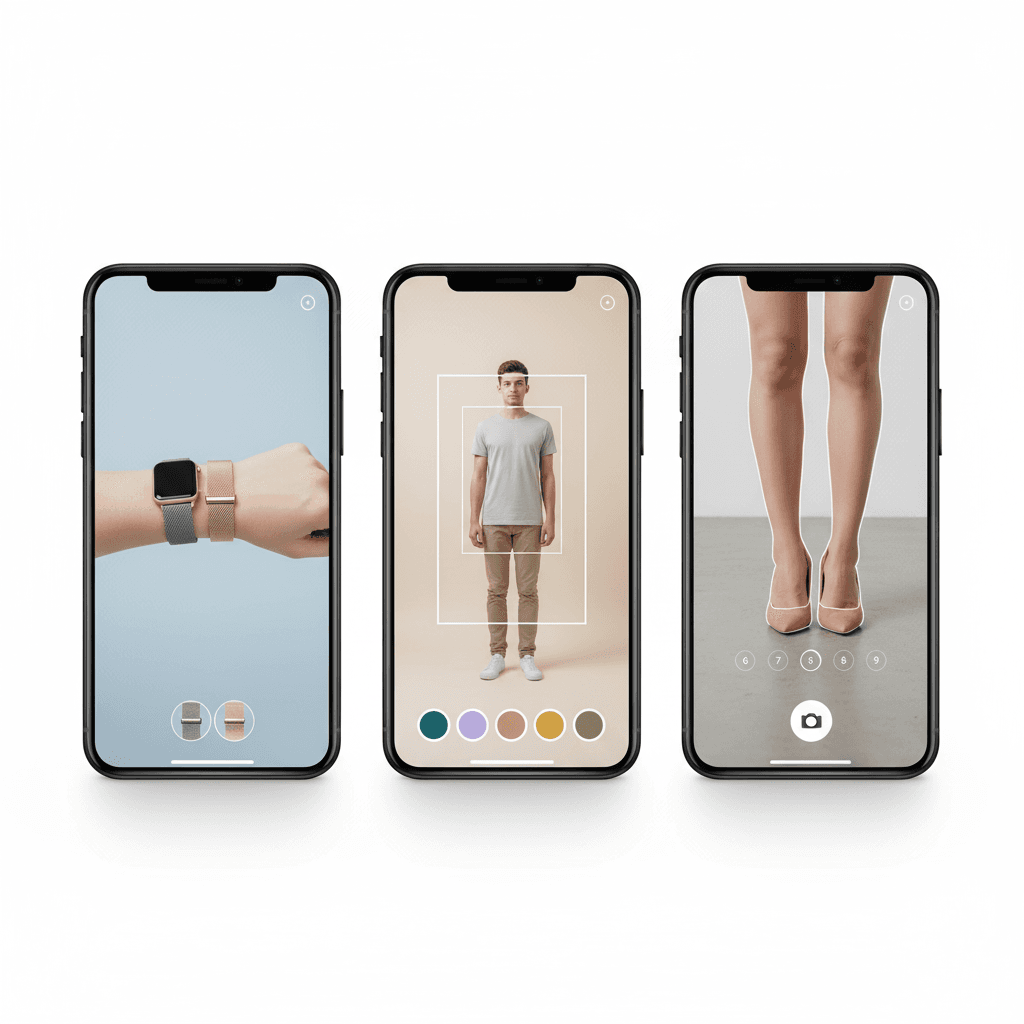How Augmented Reality Retail Shopping Is Changing Fashion?
Generative AI in eCommerce: Better Than Traditional Models?


TL;DR
Generative AI in eCommerce is transforming how brands connect with shoppers. Unlike traditional eCommerce websites that offer static experiences, AI for eCommerce websites delivers hyper-personalized, predictive, and dynamic journeys. Stats show that 71% of consumers expect tailored shopping, while brands using generative AI see up to a 35% boost in conversions. The global AI in eCommerce market is projected to reach $45.7 billion by 2030. From AI-generated content to predictive shopping assistants, the future belongs to smarter, data-driven, and human-like retail powered by generative AI.
Shopping online isn’t what it used to be. Generative AI in eCommerce is redefining how customers search, explore, and purchase. Traditional eCommerce once relied on static websites and preloaded catalogues, but AI-generated eCommerce websites are dynamic — adapting layouts, content, and recommendations in real time.
According to McKinsey, 71% of customers expect personalization, and brands using AI for eCommerce websites already see 15–20% higher order values. But the question remains: Is this the end of traditional models or the beginning of something better?
Let’s explore what’s hype, what’s real, and what could define the next era of online shopping.
What is Generative AI in eCommerce?
Generative AI in eCommerce uses advanced models that create content, designs, and product experiences based on real-time user data. It doesn’t just automate — it thinks and learns.
AI for eCommerce websites adapts continuously, helping businesses create:
- Product descriptions written dynamically for each SKU
- Personalized homepage layouts tailored to user behavior
- Conversational shopping assistants that talk like real stylists
- Visual mockups generated instantly from a text prompt
- AI-generated push notifications and email campaigns
This makes AI-generated eCommerce websites more responsive, creative, and efficient — crafting meaningful experiences at scale.
Shopping Online Then vs Now – What’s Changed with Generative AI in Ecommerce?
Back when eCommerce first took off in the 1990s, online shopping was more of a digital catalog experience. You had to manually search for what you needed, scroll through endless product listings, check specifications line-by-line, and often end up second-guessing your choice.
You’d wait 5–7 days for delivery, only to find that the product didn’t fit or match the image. Then came the hassle of returns—long forms, delayed pickups, and vague refund timelines. Customer support? Often buried in email loops or chatbots that couldn’t really help. Stockouts were frequent, recommendations felt random, and loyalty was hard-earned.
But that’s changing—and Generative AI is right at the heart of it.
Today, shopping experiences are hyper-personalized and predictive with AI-powered ecommerce. Generative AI enables platforms to understand your preferences, suggest products you’re likely to love (not just click), and even generate personalized bundles or offers in real-time. It can simulate product try-ons before buy, auto-write engaging descriptions, and even provide human-like virtual assistants to handle your queries instantly.
Returns are smarter too—AI can predict size mismatches before you buy. Inventory? Managed dynamically through AI-driven demand forecasts. And that email you just got with a curated set of picks? Chances are, it was generated just for you.
Meaning, you can shop with predictive, intuitive, and customer-first—experince that traditional eCommerce has struggled to scale.
Certainly. Here’s a thoughtful, nuanced section addressing whether traditional eCommerce is obsolete or unworthy, while maintaining a balanced, professional tone that reflects deep research and industry insight:
Is the Traditional eCommerce Approach Obsolete or Unworthy?
Now, when we know about the importance of Generative AI, It’s easy to assume that traditional eCommerce models have become outdated or even irrelevant. But the reality is more complex. Traditional eCommerce laid the foundation for the digital marketplace as we know it—enabling mass access to products, creating global reach, and building customer trust through reliable platforms.
It’s true that traditional eCommerce methods face significant limitations in today’s rapidly evolving market. They often struggle with static user experiences, limited personalization, and reactive rather than proactive customer engagement. But traditional eCommerce doesn’t rely heavily on collecting personal data or pushing customers to overshop. It offers a more straightforward shopping experience without the constant nudges or automated upselling tactics. For many consumers, this simplicity and privacy can still feel reassuring in an increasingly data-driven world.
Generative AI in E-Commerce and Traditional Models: Benefits and Limitations
Generative AI in eCommerce: Benefits
- Personalized recommendations and marketing at scale
- Real-time site adaptation to user behavior
- Automated customer journeys and dynamic pricing
- Creative content generation boosting engagement
- Proven increase in conversion and order values
Generative AI in eCommerce: Limitations
- High setup cost and tech complexity
- Privacy concerns with data use
- Integration challenges with legacy systems
- Risk of reduced human interaction
Traditional eCommerce: Benefits
- Simple, stable, and easy to manage
- Less data collection, better for privacy
- Predictable costs, suitable for smaller businesses
- Familiar shopping experience
Traditional eCommerce: Limitations
- Limited personalization and static UX
- Reactive rather than proactive customer engagement
- Slower to adapt to market changes
- Higher cart abandonment rates
Traditional vs Generative AI in E-Commerce: A Comparison
Feature | Traditional eCommerce (Without AI) | Generative AI-Powered eCommerce |
Product Discovery | Manual search and filters, static results | AI-generated personalized recommendations, adaptive content creation |
Customer Support | Email and live agents, slower response | AI chatbots generating dynamic, real-time solutions and personalized guidance |
Content & UX | Static pages, same for all users | Dynamically generated content and layouts tailored per user context |
Checkout Experience | Multi-step, manual input | Smart autofill, conversational checkout powered by AI-generated prompts |
User Engagement | Generic promotions and offers | Hyper-personalized marketing messages created by AI based on individual behavior |
Product Suggestions | Based on general popularity and trends | AI-generated bundles and offers customized to unique customer profiles |
Inventory Display | Fixed product catalogs, limited stock views | Virtual inventory expanded via AI-driven product metadata and recommendations |
Feedback Loop | Manual surveys, static reviews | Real-time data analysis with AI generating actionable insights and content updates |
Why Shoppers Love Generative AI in eCommerce
Consumers prefer personalized experiences over one-size-fits-all sites.
According to Deloitte, 80% of online shoppers are more likely to buy from a brand offering personalization, and generative AI in eCommerce enables that at scale.
Platforms like Glance AI show how this plays out — through digital twins that replicate a user’s style and preferences, helping them visualize clothing or accessories in real time. That’s not just engagement — that’s emotional connection powered by AI.
Should Your Business Adopt Generative AI in Ecommerce?
Generative AI isn’t here to replace traditional eCommerce—it’s here to refine it. The real question isn’t if your business should adopt it, but how soon. As consumer expectations rise, and competition tightens, the edge lies in how intelligently your platform can adapt, predict, and engage.
Here’s how Generative AI is reshaping eCommerce—and why your business should consider it:
Smart Inventory Management
Generative AI can forecast demand with greater accuracy, minimizing stockouts or overstock situations by dynamically generating supply strategies based on real-time buying behavior.
Deeper Customer Insights
Beyond basic analytics, Gen AI interprets patterns—like browsing journeys and drop-offs—to generate nuanced customer personas and optimize product positioning accordingly.
Virtual Shopping Assistants
AI-generated conversational interfaces provide personalized buying guidance, making digital shopping feel like an assisted in-store experience.
Immersive Product Experiences
With AR powered by generative models, customers can visualize products in real-world contexts—trying on apparel, testing furniture layout, or viewing products in 3D—without leaving home.
Ultimately, helping you boost conversions, reduce cart abandonment, personalize every touchpoint, and significantly enhance customer satisfaction, driving faster growth with leaner operations.
ROI for Businesses Adopting Gen AI Leaving Traditional Models Behind
Businesses adopting GenAI tools report:
- 30–50% reduction in content production timelines
- 20–35% boost in conversion rates
- Faster customer resolutions and fewer escalations
- Higher average order values due to better personalization
How to Adopt GenAI for Your Business?
Whether you are a proper physical business or traditional ecommerce, you can start adopting the Generative AI in ecommerce. And to be honest, building a GenAI-powered eCommerce website doesn’t mean overhauling everything overnight. It’s a strategic shift, you may execute in three focused phases:
Phase 1: Foundation – Start with Data and Use Cases
- Identify where GenAI can make the most impact: product discovery, customer support, or content generation.
- Ensure your data is clean, structured, and privacy-compliant.
- Use plug-and-play GenAI tools for small wins—like automated product descriptions or chatbot integrations.
Practical Impact: You reduce manual effort while testing AI’s potential without disrupting your core operations.
Phase 2: Integration – Connect GenAI into the Shopping Journey
- Move beyond point solutions—integrate GenAI into recommendation engines, personalized search, and email marketing.
- Focus on customer-facing elements to enhance UX and increase engagement.
- Use APIs or AI-native platforms to connect insights from browsing behavior to conversion strategies.
Practical Impact: Boost conversion rates and customer retention with hyper-personalized, always-relevant experiences.
Phase 3: Optimization – Scale and Learn Continuously
- Let GenAI fine-tune inventory, pricing, and content in real time.
- Implement feedback loops to train AI models based on live behavior and outcomes.
- A/B test AI-driven changes vs traditional to keep refining what works best.
Practical Impact: Create a continuously learning ecosystem that gets smarter, faster, and more aligned with user expectations every day.
Best Tools to Shift from Traditional eCommerce to Generative AI-Powered eCommerce
If you're considering moving from conventional eCommerce setups to a more intelligent, GenAI-powered eCommerce website, here are essential tools across key functions to help your business transition effectively:
Content Creation
- Jasper.ai – Generates persuasive product descriptions, blogs, and emails tailored to your brand voice and sales goals.
- Writer – An enterprise-ready AI writing assistant that ensures content stays consistent, clear, and compliant.
Why: Reduces time-to-market, eliminates content bottlenecks, and ensures tone consistency across platforms.
Visual Commerce
- Midjourney – Helps create unique product renders, ads, and social visuals through AI-generated imagery.
- Vue.ai – AI for catalog management, product tagging, and even visual styling—all automated.
Why: Cuts costs on photography, speeds up visual content production, and enhances merchandising efficiency.
Personalized Engagement
- Maverick – Automates personalized video outreach for abandoned carts, loyalty programs, or post-purchase touchpoints.
Why: Boosts engagement, drives repeat purchases, and improves overall customer retention.
Voice & Chat Interfaces
- ElevenLabs – Transforms content into high-quality voice experiences—ideal for AI shopping assistants and voice search.
- ChatGPT (OpenAI) – Offers conversational AI chatbots for real-time support, product discovery, and upselling.
Why: Reduces customer service load, enhances shopping convenience, and improves satisfaction scores.
Conclusion
The debate between generative AI in eCommerce and traditional models isn’t about replacement — it’s about evolution. Traditional eCommerce offers familiarity and trust, while AI introduces adaptability and precision.
The future lies in the fusion — AI for eCommerce websites powering intelligence and personalization, while traditional practices maintain reliability. Generative AI is not the future of eCommerce — it’s the present that’s already shaping tomorrow.
FAQs
What is generative AI in eCommerce?
Generative AI in eCommerce leverages advanced machine learning to create personalized content, product recommendations, and dynamic shopping experiences in real time. It can generate product descriptions, marketing visuals, and AI-powered interactions while analyzing customer behavior to optimize offers, pricing, and inventory. By automating these tasks, generative AI helps retailers enhance efficiency, increase engagement, and deliver highly tailored shopping experiences.
How does Amazon use generative AI?
Amazon uses generative AI to power personalized product recommendations, automate customer service through chatbots, optimize inventory forecasting, and generate marketing copy at scale.
How does generative AI help in eCommerce?
Generative AI helps eCommerce by creating personalized product recommendations, automating customer support, and generating targeted marketing content. It can also adapt website experiences to individual user behavior in real time, enhance search functionality, and assist with tasks like product data enrichment. By automating these processes, generative AI improves efficiency, increases engagement, and delivers highly tailored shopping experiences for every customer.
What is a generative AI website?
A generative AI website uses artificial intelligence to dynamically create and adapt content, layouts, and product recommendations based on user behavior, preferences, and real-time data. It can generate personalized text, images, or product suggestions, improving engagement and user experience. By continuously learning from interactions, these websites deliver tailored shopping or browsing experiences that evolve with each visitor.
Is AI better than traditional shopping?
AI is better for shoppers who want speed, personalization, and convenient discovery. It quickly narrows options and suggests what fits your style or needs. Traditional shopping, however, is better if you prefer a tactile, sensory experience or enjoy browsing in person. Most people find that a balance works best using AI for ease and in-store visits for confidence and connection.
What is the best use of AI in eCommerce?
The best use of AI in eCommerce is making shopping feel easier and more personal. AI helps shoppers find the right products faster through tailored recommendations, smarter search, and conversational guidance. It also streamlines behind-the-scenes tasks like pricing and inventory, creating a smoother, more efficient experience for both shoppers and brands.
How is AI used to improve customer experience?
AI improves customer experience by making interactions faster, more helpful, and more personal. It suggests relevant products, answers questions instantly through chat support, predicts what customers may need next, and helps resolve issues more efficiently. This leads to smoother journeys, quicker decisions, and a more satisfying overall shopping experience.
How Generative AI Is Changing the Face of eCommerce?
Generative AI in eCommerce creates personalized content, dynamic layouts, and curated experiences—transforming static shopping into real-time, tailored journeys for each user across search, styling, and support.







